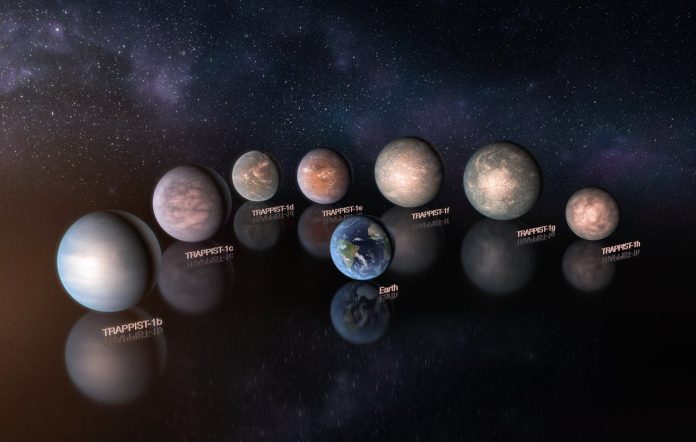A new study has found that the seven planets orbiting the nearby ultra-cool dwarf star TRAPPIST-1 are all made mostly of rock, and some could potentially hold more water than Earth.
A team of astronomers including Eric Agol of the University of Washington has found that the seven Earth-sized planets orbiting the star TRAPPIST-1 are all made mostly of rock, and some could even have more water — which can give life a chance — than Earth itself.
The research was led by Simon Grimm of the University of Bern in Switzerland, and published Feb. 5 in the journal Astronomy and Astrophysics. Agol is among about two dozen co-authors. The scientists created computer models to simulate the planets based on available information.
TRAPPIST-1 is an ultra-cool dwarf star about 40 light-years — or about 235 trillion miles — from Earth in the Aquarius constellation. Astronomers confirmed its seven potentially habitable planets in early 2017 using the NASA Spitzer Space Telescope and the European Southern Observatory’s La Silla Observatory in Chile. It is the first known system with so many Earth-sized planets orbiting a single star.
TRAPPIST-1’s seven planets — labeled TRAPPIST-1b though h, moving outward from the star — orbit more closely to it than Mercury does the sun, which would be too close for potential habitability in our own system. But because the star is faint, its habitable zone — the swath of space around it just right to allow an orbiting rocky planet to sustain water on its surface — lies closer in, so orbiting planets could still, in theory, hold liquid water. Some may be tidally locked, with the same side forever facing the star.
In fact, the worlds orbit TRAPPIST-1 so closely, a person standing on the surface of one would have a spectacular view of the neighboring planets — some appearing in the sky larger than the moon looks from Earth.
The planets’ densities, now known much more precisely than before, suggest that some of them could have up to 5 percent of their mass in the form of water — about 250 times more than Earth’s oceans. The hotter, closer-in worlds likely have dense, steamy atmospheres, and the more distant ones icy surfaces.
In terms of size, density and the amount of radiation it receives from its star, the fourth planet out, TRAPPIST-1e, is the most similar to Earth, though slightly denser. It seems to be the rockiest planet of the seven, and has the potential to host liquid water. TRAPPIST-1f, g and h are far enough from the star, water could be frozen across their surfaces.
The researchers were able to calculate densities of the planets because they are aligned such that as they pass in front of their star, Earth- and space-based telescopes can detect a dimming of its light, called a transit. The amount by which the starlight dims is related to the radius of the planet.
The team used what are called “transit timing variations,” or TTV — a method Agol assisted in developing over recent years — to learn the density of the planets. Minus other gravitational forces, a transiting planet will always cross in front of its host star in the same amount of time — just as the Earth orbits the sun like clockwork every 365 days.
But because the TRAPPIST-1 planets are packed so close together, they affect one another gravitationally, slightly changing the timing of each other’s “years.” Those variations in orbital timing are used to estimate the planets’ masses.
Agol performed the TTV calculations in parallel with lead author Grimm. “We obtained the same masses for the planets,” he said, “which was great to have concordance, and increased our faith that neither was making any mistakes.”
Then mass and radius are in turn used to calculate density.
Agol, a UW professor of astronomy — supported in this work by a Guggenheim fellowship — is affiliated with the NASA Astrobiology Institute’s Virtual Planetary Laboratory, based at the UW. Other co-authors are from Université de Liège, Liège, Belgium; Cambridge University; the University of Birmingham in the UK, the Massachusetts Institute of Technology, the University of Bordeaux; University of California, San Diego; the University of Chicago, the California Institute of Technology and several other institutions.
The next step, researchers say, in exploring the TRAPPIST-1 system, researchers say, will be to use NASA’s coming James Webb Telescope to study the atmospheres of these worlds.
“A goal of exoplanet studies for some time has been to probe the composition of planets that are Earth-like in size and temperature,” said Agol. “The discovery of TRAPPIST-1 and the capabilities of ESO’s facilities in Chile and the NASA Spitzer Space Telescope in orbit have made this possible — giving us our first glimpse of what Earth-sized exoplanets are made of.”
Sean Carey, manager of the Spitzer Science Center at Cal Tech, said, “We now know more about TRAPPIST-1 than any other planetary system apart from our own.”















